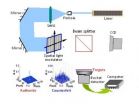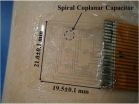(Press-News.org) WASHINGTON D.C., June 24, 2014 – "Ghost imaging" sounds like the spooky stuff of frivolous fiction, but it's an established technique for reconstructing hi-res images of objects partly obscured by clouds or smoke. Now a group of researchers at the National University of Singapore (NUS) is applying the same idea in reverse to securing stored or shared electronic data.
Described in the journal Applied Physics Letters, from AIP Publishing, the work establishes "marked ghost imaging" technology as a new type of multi-layer verification protocol for data storage or transmission.
By "ghosting up" data, the scientists can hide the contents of electronic communications from hackers, deconstructing it into multiple foggy files that make no sense on their own and can only be reconstructed by someone who has the right decoder key (technically called a "reference intensity sequence").
"The sender can send out a huge number of different reference intensity sequences -- only one is authentic, and others are counterfeit -- for confusing the attackers," said Wen Chen, an NUS professor who led the work with co-author Xudong Chen.
"This novel method based on ghost imaging can dramatically enhance system security, and it may be straightforward to apply it to other optical security systems," Chen added.
How the Technology Works
Information security has become one of the most important social and academic topics in recent years as massive increases in data storage have coincided with rapidly developing modern technologies for accessing that data virtually anywhere. Imaging technology has attracted more and more attention in computer security circles because of its promise to enhance the security of data storage or transmission, which is what led Chen and colleagues to develop their marked ghost imaging technology based on traditional optical ghost imaging.
Traditional ghost imaging uses digital cameras to detect light bouncing directly off of an object as well as light that does not directly bounce from the object to the detector. It allows solid images of objects to be reconstructed by shining light into a beamsplitter and separating it into two correlated beams -- one directed at the object and the other, reference arm directed at the camera lens. When these two beams are correlated, they create a silhouette image of the object.
Chen and colleagues report that they can do the same thing either virtually, using software, or physically, by altering the optics of the data transmission. Their technology allows them to create highly-sparse reference intensity patterns that act as security keys and lowly-sparse intensity patterns of the object as ciphertexts, the information being decoded. To decode object data, the reference-arm patterns are then processed to 'rebuild' one new reference intensity sequence. This is crucial because requiring only one rebuilt intensity sequence doesn't increase the system's complexity, while allowing multiple marks (the keys) to be hidden.
Future research includes analysis of the upper limit of keys that can be embedded without increasing the system's complexity and developing greater robustness of the system against attacks.
INFORMATION:
The article, "Marked ghost imaging" is authored by Wen Chen and Xudong Chen. It will be published in the journal Applied Physics Letters on June 24, 2014. After that date, it may be accessed at: http://scitation.aip.org/content/aip/journal/apl/104/25/10.1063/1.4879843
ABOUT THE JOURNAL
Applied Physics Letters features concise, rapid reports on significant new findings in applied physics. The journal covers new experimental and theoretical research on applications of physics phenomena related to all branches of science, engineering, and modern technology. See: http://apl.aip.org
Ghost writing the whip
New, enhanced security of data storage and transmission via optical 'marked ghost imaging' technology developed at the National University of Singapore
2014-06-24
ELSE PRESS RELEASES FROM THIS DATE:
Researchers mapping your route from illness to illness
2014-06-24
This is the first time that researchers have analysed big data relating to an entire country's disease development. The new ground-breaking results are based on data from 6.2 million Danes who were followed for 14.9 years – using state-of-the-art systems biology, researchers have boiled down the massive amount of data to 1,171 so-called thoroughfares with central information on the course of diabetes, chronic obstructive pulmonary disease, cancer, arthritis and cardiovascular disease. The researchers are, in other words, able to forecast whether you are driving on a risky ...
New technology: The goose bump sensor
2014-06-24
WASHINGTON D.C., June 24, 2014 – Can emotional states be measured quantitatively, and if so what would advertising, manufacturing and social media companies do with that data? Imagine a world in which a consumer's real-time physical and emotional response helped to determine his/her experience of music, online ads or the temperature in the room.
That may not be so far away -- a team of researchers at KAIST in Daejeon, South Korea has developed a flexible, wearable 20mm x 20mm polymer sensor that can directly measure the degree and occurrence on the skin of goose bumps ...
Roux-en-Y gastric bypass surgery may reduce heart disease risk
2014-06-24
CHICAGO, IL—Obese patients with Type 2 diabetes who don't have excessive surgical risk may find that Roux-en-Y gastric bypass (RYGB) surgery can help them reduce their risk of heart disease, a new clinical trial shows. The results were presented Tuesday at ICE/ENDO 2014, the joint meeting of the International Society of Endocrinology and the Endocrine Society in Chicago.
"There is emerging evidence highlighting the potential health benefits of bariatric surgery in managing obese patients with Type 2 diabetes. In the past, lifestyle advice and medications provided the ...
Sleep, mood improves after substantial weight loss
2014-06-24
CHICAGO, IL—Obese adults who lose at least 5 percent of their body weight report that they sleep better and longer after six months of weight loss, according to a new study. The results were presented Tuesday at the joint meeting of the International Society of Endocrinology and the Endocrine Society: ICE/ENDO 2014 in Chicago.
"This study confirms several studies reporting that weight loss is associated with increased sleep duration," said the study's lead investigator, Nasreen Alfaris, MD, MPH, a fellow in the Department of Medicine at the Perelman School of Medicine ...
Gastric bypass surgery improves diabetic patients' quality of life
2014-06-24
CHICAGO, IL—An intensive weight loss program involving lifestyle modifications improves obese diabetic patients' physical and mental health as well as gastric bypass surgery does over two years, but the weight loss surgery leads to a greater reduction in adverse effects of obesity on quality of life. These results, from a new study in patients with Type 2 diabetes, were presented Tuesday at the joint meeting of the International Society of Endocrinology and the Endocrine Society: ICE/ENDO 2014 in Chicago.
Gastric bypass also led to patients having a somewhat greater reduction ...
Synthetic triterpenoids show promise in preventing colitis-associated colon cancer
2014-06-24
Researchers from Case Western Reserve and Dartmouth universities have shown that a class of small antioxidant molecules carries enormous promise for supressing colon cancer associated with colitis. These findings, published in an early June edition of the Journal of Clinical Investigation, offer hope that physicians ultimately will be able to reduce dramatically the number of sufferers of this inflammatory bowel disease (IBD) who go on to develop colon cancer.
The molecules, known as synthetic triterpenoids, appear to achieve their positive effect in two ways. First, ...
Helpful bouncing babies show that moving together to music builds bonds
2014-06-24
HAMILTON, ON, June 24, 2014 — Whether they march in unison, row in the same boat or dance to the same song, people who move in time with one another are more likely to bond and work together afterward.
It's a principle established by previous studies, but now researchers at McMaster University have shown that moving in time with others even affects the social behavior of babies who have barely learned to walk.
"Moving in sync with others is an important part of musical activities," says Laura Cirelli, lead author of a paper now posted online and scheduled to appear ...
Food scientists working to diminish, mask bitter tastes in foods
2014-06-24
Food scientists are working to block, mask and/or distract from bitter tastes in foods to make them more palatable to consumers, many of whom are genetically sensitive to bitter tastes, according to a new presentation at the 2014 Institute of Food Technologists (IFT) Annual Meeting & Food Expo® in New Orleans.
"Many factors go into why we eat what we do," said John Hayes, PhD, assistant professor of food science and director of the Sensory Evaluation Center at Pennsylvania State University, with taste consistently ranking as number one. There's also "a huge variability ...
Not everyone wants cheering up, new study suggests
2014-06-24
You may want to rethink cheering up your friends who have low self-esteem because chances are they don't want to hear it.
People with low self-esteem have overly negative views of themselves, and often interpret critical feedback, romantic rejections, or unsuccessful job applications as evidence of their general unworthiness. A new study from researchers at the University of Waterloo and Wilfrid Laurier University found that they likely don't want you to try to boost their spirits.
"People with low self-esteem want their loved ones to see them as they see themselves. ...
Metal particles in solids aren't as fixed as they seem, new memristor study shows
2014-06-24
ANN ARBOR—In work that unmasks some of the magic behind memristors and "resistive random access memory," or RRAM—cutting-edge computer components that combine logic and memory functions—researchers have shown that the metal particles in memristors don't stay put as previously thought.
The findings have broad implications for the semiconductor industry and beyond. They show, for the first time, exactly how some memristors remember.
"Most people have thought you can't move metal particles in a solid material," said Wei Lu, associate professor of electrical and computer ...
LAST 30 PRESS RELEASES:
School meals could unlock major gains for human and planetary health
Menopause hormone therapy does not appear to impact dementia risk
Signature patterns of brain activity may help predict recovery from traumatic brain injury
Dresden study uncovers new key mechanism in cancer cells
New species are now being discovered faster than ever before, study suggests
Cannabis-based products show limited short-term benefit for chronic pain, with increased risk of adverse effects
Cannabis products with more THC slightly reduce pain but cause more side effects
Clearing the brain of aging cells could aid epilepsy and reduce seizures
Brain injuries linked with potential risk of suicide, new study finds
New technique lights up where drugs go in the body, cell by cell
New study finds movement of fishing fleets can reveal shifts in marine ecosystems
Embargoed: New evidence points to potential treatment for vascular dementia
Study uncovers disrupted brain balance in alcohol dependence
Working in groups can help Republicans and Democrats agree on controversial content moderation online
Structural findings reveal how distinct GPCR ligands create different levels of activation
Anything-goes “anyons” may be at the root of surprising quantum experiments
UC review: Maximizing workplace opportunity for veterans
From generation to complex control: Metasurfaces make perfect vortex beams "within reach"
Thin-film lithium niobate-based detector: recent advances and perspectives
Exploring why some people may tend to persistently make bad choices
How cells balance their protein levels
Nirsevimab vs RSVpreF vaccine for RSV–related hospitalization in newborns
Effectiveness and impact of maternal RSV immunization and nirsevimab on medically attended RSV in US children
AI gives scientists a boost, but at the cost of too many mediocre papers
Next-generation vision model maps tree growth at sub-meter precision
Genes aren’t destiny for inherited blindness, study shows
MIT study: High-fat diets make liver cells more likely to become cancerous
Exposure to multiple fine particulate matter components and incident depression in the US Medicare population
Risk of burdensome health care spending over time in the US
Nirsevimab against hospitalizations and emergency department visits for lower respiratory tract infection in infants
[Press-News.org] Ghost writing the whipNew, enhanced security of data storage and transmission via optical 'marked ghost imaging' technology developed at the National University of Singapore

